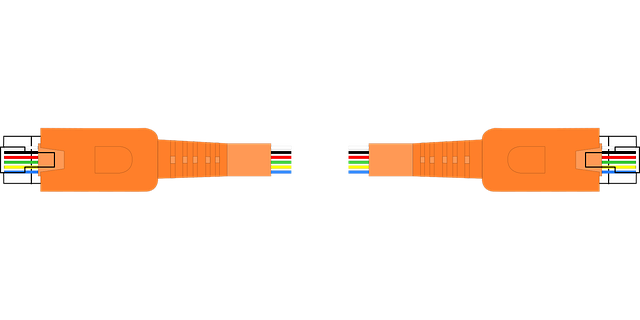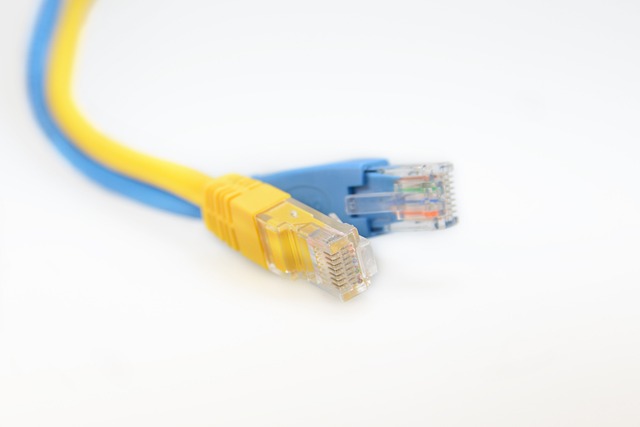Category: Wireless Network Cabling
Wireless Network Cabling: Unlocking a Connected World
Introduction
In our increasingly digital age, wireless network cabling has emerged as a pivotal technology, enabling seamless connectivity across homes, businesses, and global communication networks. This comprehensive article aims to delve into the intricate world of wireless networking, exploring its definition, history, global impact, economic implications, technological innovations, regulatory landscape, challenges, successful implementations, and an exciting glimpse into its future potential. By the end of this journey, readers will grasp why wireless network cabling is not just a technical concept but a catalyst for societal progress.
Understanding Wireless Network Cabling: Unraveling the Fundamentals
Definition: Wireless network cabling refers to the infrastructure that facilitates communication between devices without the physical constraints of cables. It involves a complex interplay of hardware, software, and radio frequency (RF) technologies to transmit data wirelessly.
At its core, this technology includes several key components:
-
Access Points (APs): These are devices that act as gateways for wireless communication, connecting mobile devices to wired networks. APs can be standalone units or integrated into routers.
-
Routers: Routers play a vital role in directing data traffic between different networks and ensuring efficient data transfer. They are essential for creating mesh networks and extending coverage.
-
Antennas: Antennas, often omnidirectional or directional, are responsible for transmitting and receiving RF signals. Their design and placement significantly impact the strength and range of wireless connections.
-
Wireless Standards: Various standards like Wi-Fi (802.11 a/b/g/n/ac/ax) define the communication protocols, data rates, and security measures for wireless networks. Each standard builds upon the previous one, offering faster speeds and enhanced capabilities.
Historical Context: The concept of wireless networking has its roots in the late 19th century when inventors like Guglielmo Marconi pioneered radio communication. However, practical applications emerged in the early 2000s with the advent of Wi-Fi technology, which revolutionized how we connect to the internet. Since then, continuous research and development have led to significant improvements in wireless network cabling’s speed, reliability, and security.
Global Impact and Trends: A Network Without Borders
Wireless network cabling has left an indelible mark on the global stage, fostering connectivity across continents and transforming how we interact with technology. Here’s a glimpse into its international influence and shaping trends:
| Region | Impact and Initiatives |
|---|---|
| North America | The United States and Canada have been early adopters of wireless technologies, driving innovation in 5G deployment and smart city infrastructure. Regions like Silicon Valley are hotspots for wireless research and development. |
| Europe | European countries are at the forefront of implementing high-speed broadband networks, aiming to bridge the digital divide. Initiatives like the EU’s Digital Single Market strategy promote universal access to high-speed internet, including wireless solutions. |
| Asia Pacific | This region is witnessing rapid urbanization and a surge in demand for wireless connectivity. Countries like Japan and South Korea have leading 5G networks, while India focuses on expanding broadband access through various government schemes. |
| Latin America | Wireless network cabling is playing a crucial role in connecting remote communities and promoting digital literacy. Brazil and Mexico are notable for their efforts to bridge the digital divide with affordable wireless internet services. |
| Africa | The African continent presents unique challenges, but wireless technology is making significant strides. Projects like the Connect Africa Initiative aim to provide broadband access across the continent, empowering local communities through connectivity. |
Trends Shaping the Future:
-
5G and Beyond: The rollout of 5G networks globally is a game-changer, offering unprecedented speeds and low latency. This technology is enabling advancements in autonomous vehicles, augmented reality (AR), and the Internet of Things (IoT).
-
Internet of Things (IoT): As IoT devices become more prevalent, wireless networking plays a critical role in connecting them to create smart homes, cities, and industries.
-
Cloud Computing Integration: The integration of cloud services with wireless networks enhances data accessibility and enables remote work, further fueling the demand for robust wireless infrastructure.
-
Security Enhancements: With increasing cyber threats, wireless network providers are focusing on enhancing security protocols to protect user data and prevent unauthorized access.
Economic Considerations: A Digital Economy Driver
The economic implications of wireless network cabling are profound, influencing various sectors and contributing to global economic growth.
-
Market Dynamics: The global wireless networking market was valued at USD 267.5 billion in 2021 and is projected to grow at a CAGR of 13.8% from 2022 to 2030 (Source: Grand View Research). This growth is driven by the increasing demand for high-speed internet, IoT deployments, and 5G infrastructure.
-
Investment Patterns: Governments and private sector entities are investing heavily in wireless network infrastructure. For instance, global 5G investments reached an estimated $160 billion in 2020, with countries like China leading the way (Source: GSMA).
-
Job Creation: The industry’s growth has led to the creation of numerous job opportunities, ranging from network engineers and technicians to software developers and IoT specialists.
-
Digital Economy Boost: Wireless connectivity is a cornerstone of the digital economy, enabling e-commerce, online services, and remote work. According to a report by the International Telecommunication Union (ITU), mobile internet penetration contributed $4.2 trillion to global GDP in 2021.
Technological Innovations: Pushing the Boundaries
Wireless network cabling has witnessed remarkable technological advancements, pushing the boundaries of what was once thought possible.
-
MIMO (Multiple Input Multiple Output): This technology allows multiple data streams to be transmitted simultaneously over a single channel, significantly increasing data capacity and reliability. MIMO is a key enabler for high-speed Wi-Fi and 5G networks.
-
Beamforming: Beamforming techniques enable antennas to focus signals in specific directions, improving range and reducing interference. This technology is crucial for directional wireless communications.
-
Software-Defined Networking (SDN): SDN allows network administrators to manage and optimize wireless networks programmatically, making them more flexible and adaptable to changing demands.
-
Low-Power Wide-Area Networks (LPWANs): LPWAN technologies like LoRaWAN and NB-IoT are designed for long-range, low-power communication, ideal for IoT applications in remote areas.
Regulatory Landscape: Ensuring Fair Play
The regulatory environment plays a vital role in shaping the wireless networking industry and ensuring consumers’ rights. Key players in this space include:
-
International Telecommunication Union (ITU): The ITU sets global standards and guidelines for telecommunication, including wireless technologies.
-
National Telecommunications Regulatory Authorities: Each country has its own regulatory body that oversees wireless network operations, spectrum allocation, and consumer protection. For instance, the Federal Communications Commission (FCC) in the US and Ofcom in the UK.
-
Spectrum Management: Effective management of radio frequency spectrum is crucial for ensuring network performance and preventing interference. Regulators allocate spectrum for different services and technologies to optimize wireless communications.
Challenges: Overcoming Obstacles
Despite its numerous advantages, wireless network cabling faces several challenges that researchers and industry leaders are actively working to overcome:
-
Security Concerns: As more devices connect to wireless networks, the potential attack surface expands. Protecting user data and preventing cyberattacks remain critical challenges.
-
Interference Management: With the proliferation of wireless devices and networks, interference can lead to reduced signal quality and slower speeds. Advanced modulation schemes and dynamic channel selection are being developed to mitigate this issue.
-
Coverage in Remote Areas: Providing reliable connectivity in rural or remote locations remains a challenge due to geographical barriers and limited infrastructure.
-
Energy Efficiency: As wireless networks become more extensive and complex, energy consumption is a growing concern. Researchers are exploring power-efficient technologies and protocols to reduce the environmental impact.
Successful Implementaions: Real-World Impact
Wireless network cabling has found its way into various sectors, transforming industries and improving lives. Here are some notable examples:
Healthcare: Wireless networks enable remote patient monitoring, telemedicine services, and secure data sharing between healthcare facilities, enhancing patient care and reducing costs.
Education: Schools and universities are adopting wireless technologies to create digital classrooms, facilitate online learning, and provide students with access to educational resources on the go.
Smart Cities: In cities like Singapore and Amsterdam, wireless sensors and cameras are integrated into infrastructure to optimize traffic flow, enhance public safety, and improve city services.
Transportation: Wireless communication plays a critical role in autonomous vehicles, enabling real-time data exchange between cars, infrastructure, and cloud servers for safe and efficient transportation.
A Glimpse into the Future: What’s Next for Wireless Network Cabling?
The future of wireless network cabling is filled with promise and innovation, as researchers and engineers continue to push the boundaries of what is possible. Here are some exciting developments to watch:
-
6G Networks: Beyond 5G, the race to develop 6G networks is underway, aiming for even faster speeds (petabits per second), ultra-low latency, and enhanced capacity. This technology could enable applications like holographic communications and real-time remote surgery.
-
Wireless as a Service (WaaS): Similar to cloud computing models, WaaS provides wireless connectivity as a service, allowing businesses and consumers to access network resources without the need for extensive infrastructure investments.
-
AI-Powered Networks: Artificial intelligence will play an increasingly vital role in optimizing network performance, predicting congestion, and improving security by identifying anomalous behavior.
-
Integration with 5G VR/AR: Virtual and augmented reality experiences powered by 5G networks will revolutionize entertainment, education, and training simulations, creating immersive digital environments.
-
Sustainable Wireless: Researchers are exploring eco-friendly materials and energy-efficient technologies to make wireless devices and networks more sustainable, reducing their environmental footprint.
As wireless network cabling continues to evolve, it will shape our connected world, enabling new possibilities in communication, entertainment, healthcare, education, and transportation. With ongoing research, innovation, and collaboration, the future of wireless connectivity promises to be transformative and exciting.
Optimizing Network Infrastructure with PoE Cabling for Access Points

Power over Ethernet (PoE) cabling optimizes network infrastructure by integrating power and data thr…….
Mastering Wireless Access Cabling Compliance: Industry Standards

Adhering to industry standards for wireless infrastructure ensures optimal performance, safety, and…….
Optimizing Wireless Networks with High-Speed Structured Cabling

Structured cabling for wireless networks is essential for efficient data transmission with high-spee…….
Structured Cabling for Seamless Enterprise Wi-Fi Networks

Enterprise WiFi cabling optimizes network performance by tailoring solutions to specific organizatio…….
Optimizing Wi-Fi Networks with Structured Cabling Basics

Wireless network cabling relies on structured Ethernet cables (Cat5e, Cat6, Cat6a) and fiber optics…….
Structured Cabling Optimizes Wireless Access Point Performance

Wireless access cabling is vital for optimizing network performance with WAPs. Choosing appropriate…….
Structured Cabling Revolutionizes Smart Building Connectivity

Structured cabling for wireless networks is revolutionizing smart buildings by enabling seamless int…….
Streamline Enterprise WiFi: Structured Cabling Solutions for Optimal Performance

Strategic enterprise WiFi cabling involves tailoring solutions to business needs, assessing building…….
Scalable Wireless: Future-Proof Your Business Network Expansion

Wireless network cabling is a dynamic solution for businesses, offering scalability and flexibility…….
